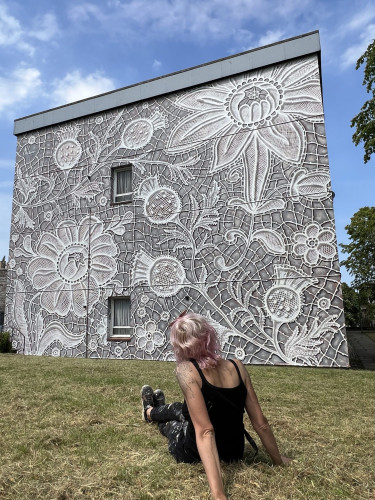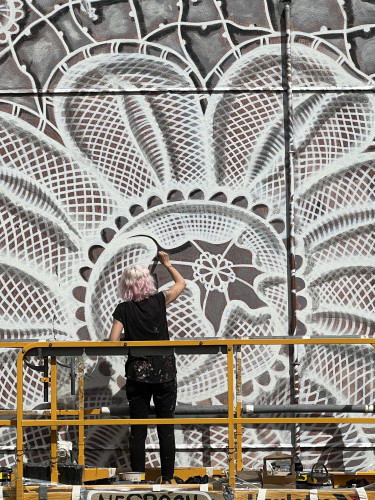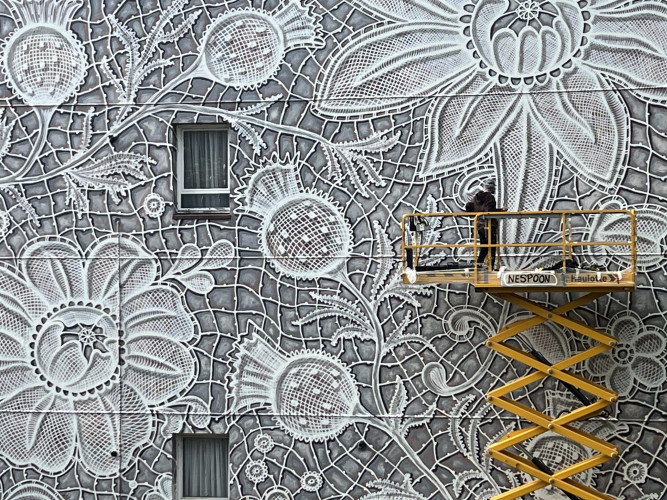Lace making is probably the most feminine art form. For the seven centuries of this craft’s existence, almost all lace makers were women, and this is still true today.
My murals are always inspired by the local lace making tradition and are a tribute to femininity and women’s empowerment. Wherever I go, I search for historical sources and local museum collections to find inspiration. I often dedicate my work to the last, disappearing groups of local lace makers.
I was lucky enough to meet one of the lace makers from the Bon Accord Bobbins Lace Group from Aberdeen, the wonderful Evelyn Currie, who told me a lot about her passion that she has been cultivating for nearly 40 years. In my mural design for Aberdeen, I used one of her lace projects as an inspiration, depicting a Scottish thistle. The Scottish thistle is the national flower of Scotland, a symbol of pride and resilience of the locals.
The history of lace making in Scotland goes back over 300 years. It was not until the middle of the eighteenth century that Anne, Duchess of Hamilton, who saw lace makers at work when travelling on the Continent, decided to provide employment for the women of her own country by introducing the art of lace making. The Duchess brought over women from France and had them teach the girls in her schools how to make “bunt lace,” as it was called.
“Edinburgh Amusement” of 1752 wrote that “The Duchess of Hamilton has ordered a home to be set up in Hamilton for the reception of twelve poor girls and a mistress. The girls are to be taken in at the age of seven, clothed, fed, taught to spin, make lace, etc., and dismissed at fourteen.” As late as 1778, we read in Locke’s Essays on the Scotch Commerce—“The lace manufactory, under the patronage of the amiable Duchess of Hamilton, goes on with success and spirit.”
Lace making in the area of Aberdeen was concentrated around New Pitsligo which is located north of the town. There were granite quarries in New Pitsligo which was understandably a male dominated industry and women in those days were looking for other ways to earn money.
At the end of the 18th century, however, lace making became less popular. Sir John Sinclair in Statistical Account of Scotland (Edinburgh, 1792. Vol. ii., 198) wrote: “A small manufacture of thread lace has long been carried on here. At an early period it was the occupation of a good many women, but, from the fluctuation of fashion, it has fallen greatly into disuse. Though the number is diminished, there are still above forty at the business, who make handsome laces of different patterns, besides those who work occasionally for themselves or their friends.
In the 19th century, hand-made lace was replaced by machine production, but the skill of hand-making lace was passed down from generation to generation. Today, in Aberdeen, the tradition of lace making is still kept alive by one group of enthusiastic lace makers, Bon Accord Bobbins, founded in 1982. Bon Accord Bobbins Lace Group meets at Ruthrieston Community Hall and is open to anyone who wants to learn this noble craft. This is one of the last examples of the beautiful tradition of women’s lace making circles that for centuries united women, maintained social ties, gave them emotional support and a source of income.
Many thanks to Martyn Reed and the wonderful Nuart team for making this project possible. Special thanks to Olivia Skalkos, Honor Greenwood, Willem Boon and Ross Grant for their help in gathering a lot of important information.


